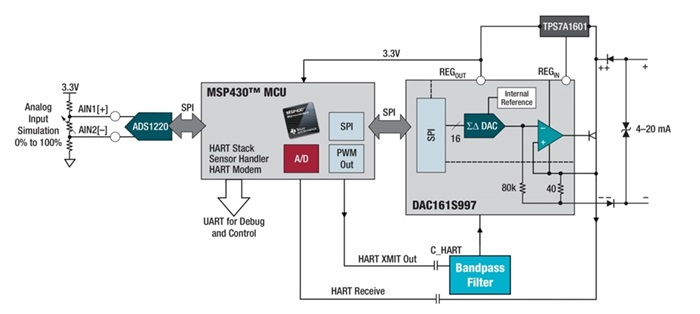SSZTBN5 February 2016 BQ25570 , MSP430FR5969
Sensing and measurement is becoming more and more important in the industrial sector. From both a factory and process automation standpoint, sensor transmitters are being added to improve system intelligence, detect faults and drive efficiency. In process automation specifically, 80 percent of the sensors have a HART 4-20mA interface. Current loops are ideal for data transmission because of their inherent insensitivity to electrical noise. The transmitter can either be powered through the communication loop via a 2-wire implementation or through a separate power line not associated directly with the 4-20mA current loop— typically classified as a 3-wire or 4-wire solution. The HART protocol provides a way for microcontrollers to send digital data across an analog channel provided by the standard pair of wires that is common in building infrastructure. Since more and more sensors are being incorporated in these loop-based systems, power consumption is a critical concern.

In this kind of communication, the resolution is by voltage controlled current source and the total current budget for 2-wire field transmitter is less than 3-3.5mA. This makes ultra-low-power microcontrollers extremely suitable for 2-wire communication loop solutions. Depending on the functionality of the sensor transmitters, which may have some sort of human-machine interface, this 3mA current limitation can become a difficult challenge to overcome. By adding energy harvesting to such a system, sensor nodes can capture, transmit and display more data without exhausting the energy provided by the current loop.
https://www.youtube.com/watch?v=nLR6k-Nk1o0
By using an ultra-low-power harvester power management IC-- such as the bq25570-- that can regulate an output for a microcontroller, a system can leverage energy in a variety of settings. A sensor near a vent could leverage wind energy to augment the current provided from the loop, a sensor measuring temperature on a hot pipe could leverage the difference in temperature between the pipe and surrounding air to generate energy as well, and there is often the potential to leverage a photovoltaic cell to collect energy from indoor light on a factory floor.
Combining energy harvesting with a 4-20mA current loop system can enable more nodes in a system and more functionality per node. This could mean that faults are detected closer to the source or that a MSP430FR5969 microcontroller with non-volatile FRAM embedded could log data more often wherever it may be placed. By collecting more data, process automation algorithms can be made more robust. In addition, functionality could be added, such as running a segment LCD controller for instant sensor readings as process supervisors walk a factory floor.
To learn more about factory automation enabled by MSP microcontrollers and TI’s energy harvesting ICs, checkout our latest application content and reference designs. View other solutions for building automation system solutions here.